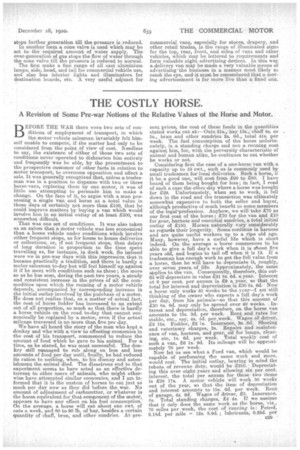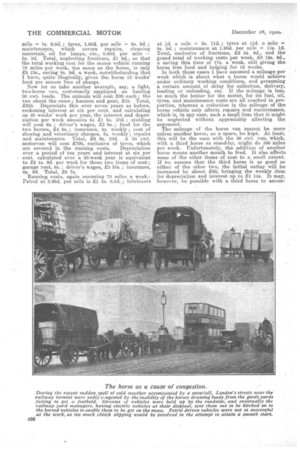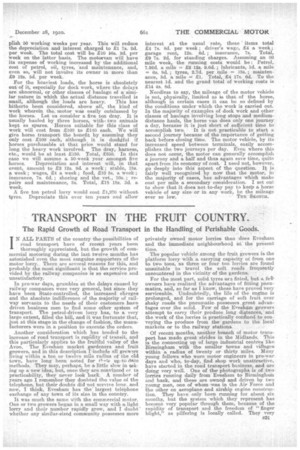THE COSTLY HORSE.
Page 15

Page 16

Page 17

If you've noticed an error in this article please click here to report it so we can fix it.
A Revision of Some Pre-war Notions of the Relative Values of the Horse and Motor.
BEFORE THE WAR there were two sets of conditions of employment . of transport, in which the motor vehicle salesman invariably felt himself unable to compete, if the matter had only to be considered from the point of view of cost. Needless to say, the existence of either of those two sets of conditions never operated to dishearten him entirely and frequentlywas he able, by the presentment to the prospective customer of other facts in relation to motor transport, to overcome opposition and effect a sale. It was generally recognized that, unless a tradesman was in a position to dispense with two or three horse-vans, replacing them by one motor, it was of little use attempting to persuade him to make a change. On the face of it, to argue with a man, possessing a single van and horse at a total value ni those days of certainly eot more than 2100, that he could improve matters by buying a van which would involve him in an initial outlay of at least 2300, was somewhat difficult.
That was one set of conditions. It was also taken as an axiom that a motor vehicle was less economical than a horse vehicle under conditions which involve either frequent stops, as for house to house deliveries or collections, or, if not frequent stops, then delays of long duration in proportion to the time spent travelling as, ter instance, in dock work. So imbued were we m pre-war days with this impression that it became practically a tradition, and there is hardly a motor salesman to-day but will feel himself up against it if he meet with conditions such as these ; the more so as he has seen, during the past two years, a steady and consistent increase in the prices of all the commodities upon which the running of a motor vehicle depends, accompanied by corresponding increase in the initial outlayinvolved by the purchase of a motor. He does not realize that, as a. matter of actual fact, the ,cost of horse fodder has increased to an extent out of all proportion, so much so that there is hardly a horse vehicle on the road to-day that cannot economically be replaced by a motor, even if the actual mileage traversed is no more than five per day.
We-have all heard the story of the man who kept a donkey and who with a view to effecting economies in the cost of his transport, commenced to reduce the amount of food which he gave to his animal. For a time, as he stated, he was most successful. The donkey still managed to rub along on less and less amounts of food per day until, finally, he had reduced its ration to nothing, when, to his dismay and astonishment the animal died. The disastrous end to that experiment seems to have acted as an effective deterrent to other users of animals, who might otherwise have attempted similar economies, and I am informed that it is the custom of horses to eat just as much per day now as they did before the war. No amount of adjustment of carburetter, Or whatever is the horse equivalent for that component of the motor; appears to have any effect on his fuel consumption. On the average, a horse will eat about one cwt. of oats a week, OM 80 to RO lb. of hay, besides a certain quantity of chaff, bran, and other sundries. At pre
sent prices, the cost of these foods in the quantities stated works out at:—Oats 21s., hay 13s., chaff 4s. or 5s., bran and other sundries 2s. 6d., total 41s. per week. The fuel consumption of the horse unfortunately, is a standing charge and not a running cost against him, for, with the perversity characteristic of animal and human alike, he continues to eat whether he works or not.
Considering first the case of a one-horse van with a capacity up to 10 cwt., such as is commonly used by small tradesmen for local deliveries. Such a horse, if it be a good one, will cost from £60 to 280. I have heard of them being bought for less; in feet, I read of such a case the other day where a horse was bought for 229. Unfortunately, when set to work, it fell down in the road and the transaction was ultimately somewhat expensive to both the seller and buyer, although productive of much benefit to some members of the legal-profession. Anyhow, we will take 270 as our first °net of the horse ; 270 for the van and 210 for gear, harness and essential sundries, a total initial outlay of 2150. Horses naturally vary considerably as regards their longevity. Some continue in I:laxness and are quite useful workers up to a ripe old age. Many, however, have a useful life which is short indeed. On the average a, horse commences to be able to give a full day's work when it is about five years old, and begins to tail off when it is 12. If a tradesman has enough work to get the full value from a horse, then he will have to depreciate it, roughly, over seven years, of life. Approximately, the same applies to the van. Consequently, therefore, this outfit will depreciate in value 221 8s. 6d. a year. Interest at 6 per cent. per annum is 29 a year, so that the total for interest and depreciation is 230 Es. 6d, Now a horse only works 40 weeks to the year—I am still thinking of the owner who expects a full day's work per day, from his animals—so that this amount of 230 8e. 6d. may only be spread over 40 weeks. . Interest and depreciation, therefore, on the horse van amounts to 15s. 3d. per week. Rent and rates for stable, etc., say, 4s. 4d. per,week. Wages of driver, 22 15s. Fodder, 22 is. Insurance, 2s. 6d. Shoeing and veterinaey charges, 2s. Repairs and maintenance of van, harness, and gear, oil for lamps, cleaning, etc, is. 6d. per week. Total weekly cost of such a van, E6 is. ed. Its mileage will be approximately '70 per week. Now let us see what a Ford van, which would be capable of performing tte same work and more, would cost. The initial outlay, bearing in mind the rebate of revenue duty, would be 2210. • Depreciating this over eight years and allowing six per cent. interest, the total per annum for these two items is 238 17s. A motor vehicle will work 50 weeks out of the year, so that the item of depreciation and interest amounts to 15s. 6d. per week. Rent. of garage, 4s. 6d. Wages of driver, 23. Insurance, 4s. Total standing charges,• £4 4s. If we assume that it only does the same work as the horse, viz., 70 miles per week, the cost of running is Petrol, 2.18d. per mile a 12s, 8.6d. ; lubricants, 0.28d. per
mile = Is. 9.6d. ; tyres, 1.60d. per mile = 9s, 9d.; maintenance, which covers repairs, cleaning materials, oil for lamps, etc., 0.00d. per mile — 5s. 3d. Total, neglecting fractions, 21 9d., so that the total working cost for the motor vehicle running 70 miles per week, the same as the horse, is only 15 13s., saving 8s. 9d. a week, notwithstanding that I have, quite illogically, given the horse 12 weeks' food per annum free of charge,
Now let us take another example, say, a light, two-horse van, customarily employed on hauling 30 cwt. loads. The animals will cost 280 each ; the van about the same; harness and gear, 115. Total, 2255. Depreciate this over seven years as before, reckoning interest at six per cent, and calculating on 40 weeks' work per year, the interest and depreciation per week amounts to if 5s. 10d. ; stabling will cost 6s. • driver's wages, 23 5s. ; food for the two horses, 4 2s. ; insurance, 4s. weekly ; cost of shoeing and veterinary charges, 4s. weekly ; repairs and maintenance. Total, 29 9s. 10d. A 30 cwt. motorva.n will cost 2700, exclusive of tyres, which
are covered in the running costs. Depreciation over a period of ten years and interest at six per cent. calculated over a 50-week year is equivalent to 22 4s. 9d. per week for those two items of cost; garage rent, Os. ; driver's wages, 23 lbs. ; insurance, Os. 3d. Total, 26 7s.
Running costs, again assurning 70 miles a week: Petrol at 3.95d. per mile is 21 3s. 0.5d..; lubricants
at •1d. a mile = 2s. 11d. ; tyres at 1-12d. a mile =Si. 9d.; maintenance at 1.90d. per mile = lie. id. Total, exclusive of fractions, 22 Si. 9d., and the grand total of working costs per week, 28 12s. 9d., a saving this time of 17s. a week, still giving the horse free food and lodging for 12 weeks. In both these cases I have assumed a mileage per week which is about what a horse would achieve under ordinary working conditions, and presuming a certain amount of delay for collection, delivery, loading or unloading, etc. If the ndleage is less, so much the better for the motor, for its fuel, oil, tyres, and maintenance costs are all reached in proportion, whereas a reduction in the mileage of the horse vehicle, only affects repairs and maintenance, which is, in any case, such a small item that it might be neglected without appreciably affecting the argument. The mileage .of the horse van cannot be more -unless another horse, as a spare, be kept.. At least, this will be the case with the 30 evit. van, which, with a third horse as .stand-by, might do 100 miles per week. Unfortunately, the addition of another horse means another mouth to feed. It also affects some of the other items of cost to a small extent. If We assume that the third horse is as good as either of the other two, the initial outlay will be increased by about 280, bringing the weekly item for depreciation and interest up to 21 14s. It may, however, be possible with a• third horse to aocom pliah 50 working weeks per year. This will reduce the depreciation and interest charged to, 21 7s. 2d. per week. The total eost will be 210 168. ad. per week on the latter basis. The motorvan will have its expense of working increased by the additional cost of petrol, oil, tyres, and maintenance, and, even so, will not involve its owner in more than 29 12s. 5d. per week. For the heaviest loads, the horse is absolutely out of it, especially for dock work, where the delays are abnormal, or other classes of haulage of a' similar nature in which the actual distance travelled is small, although the loads are heavy. This has hitherto been considered, above all, the kind of work wherein the. motor was easily outclassed by the horses. Let us consider a five ton dray. It is usually hauled by three basses, with. two animals kept as spares. 'Horses suitable for this class of work will cost from 2100 to 2140 each. We will give horse transport the benefit by assuming they only cost 2100 each, although it is doubtful if horses purchasable at that price would stand for long the heavy work involved. The dray, harness, etc., would be at least £150. Total, 2650. In this case we will assume a 50-week year amongst live horses. Depreciation and interest will, in that event, amount to 22 12s. 9d. a week ; stable, 15s. a week ; wages, 24 a week; feed, 210 5s. a week; insurance, 7s. 6d. ; shoeing and the vet., 10s.. repairs and maintenance, Es. Total, 213 18s. 3d. a week.
A five ton petrol lorry would cost 21,370 without tyres. Depreciate this over ten years and allow
interest at the usual rate, these items total 24 7s. 8d. per week ; driver'a wage, 24 a week; garage rent, 12s. 6d. ; insurance, 7s. Total, 29 7s. 2d. for standing charges. Assuming an 80 mile week, the running costs would be : Petrol, 7.92d. a mile = 22.12s. 9.6d. ; lubricants, id. a mile = 6s. 8d.; tyres, 2.7d. per mile = 38s. ; maintenance, 3d. a mile =2.1. Total, 24 17s. 6d. To the nearest Id. and the grand total of working costs is 214 4s. 8d.
Needless to say, the mileage of the motor vehicle is not, physically, limited as is that of the horse, although m certain cases it can be so defined by the conditions under which the work is carried out. In the majority of examples of dock work and other classes of haulage involving long stops and mediumdistance hauls, the horse van does only one journey a day, because it is just short of sufficient time to accomplish two. It is not practicable to start a second journey because of the importance of getting back before closing time. The motor vehicle, by its increased speed between terminals, easily accomplishes the two journeys per day. Eveu where this does not occur, the motor can generally accomplish a journey and a half and thus again save time, quite apart from its economy of cost. I need not, however, go deeply into this aspect of 'the question. It is fairly well recognized by now that the motor, in the majority of cases, has advantages which make cost per mile a secondary consideration. I set out to show that it does not to-day pay to keep a horse vehicle of any size or in any work, be the mileage ever so low. THE'SKOTML






























